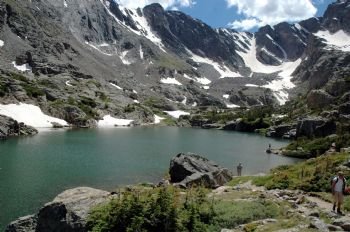 Sky Pond is one of the more popular destinations in Rocky Mountain National Park. Perhaps you’ve been there. The trail ascends through heavily traveled Glacier Gorge, past the Loch, then curves through a large, steep bowl of alpine meadows. Once you emerge from the trees into the meadow, you can see a plateau with a moderate cliff face with Timberline Falls plummeting through the middle. Steep peaks surround the falls and it’s easy to see that Sky Pond will be in the middle of these peaks, but you can’t see it yet. From this point, the falls are still tiny in the distance; it looks daunting to get there, but the hike goes more quickly than expected.
Sky Pond is one of the more popular destinations in Rocky Mountain National Park. Perhaps you’ve been there. The trail ascends through heavily traveled Glacier Gorge, past the Loch, then curves through a large, steep bowl of alpine meadows. Once you emerge from the trees into the meadow, you can see a plateau with a moderate cliff face with Timberline Falls plummeting through the middle. Steep peaks surround the falls and it’s easy to see that Sky Pond will be in the middle of these peaks, but you can’t see it yet. From this point, the falls are still tiny in the distance; it looks daunting to get there, but the hike goes more quickly than expected.
I left the trailhead early and ascended the gorge in the pearly light and arrived at Timberline Falls to find a couple sitting on a boulder eating granola. The trail sign had been dislodged and was now perched at an awkward angle, seemingly sending hikers back across the cliff face, while the trail seemed to more likely ascend a notch with its own smaller falls tumbling across it. I took a look and saw no obvious ascent line.
“Is this the trail?” I asked, pointing to the small waterfall.
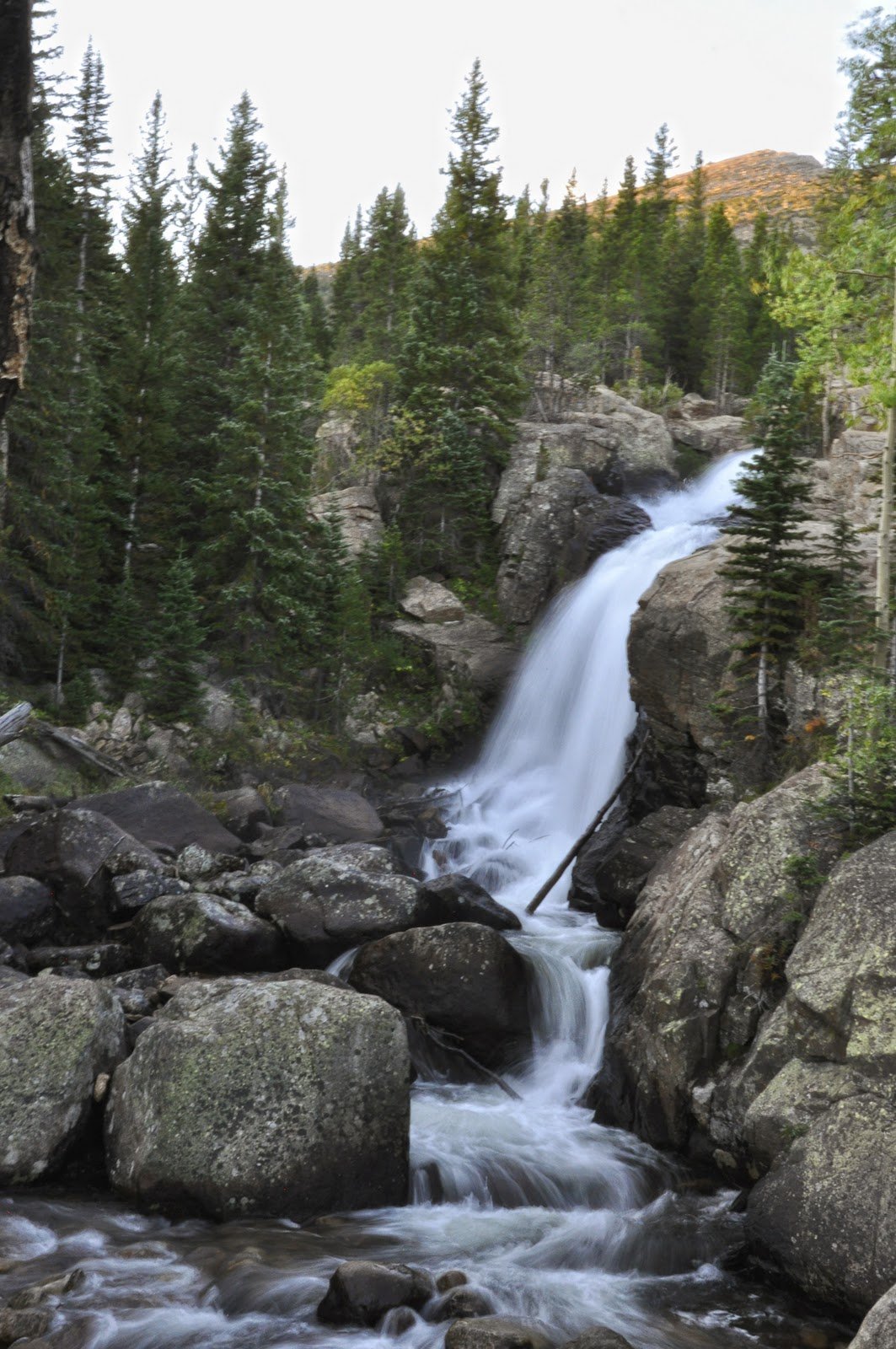 They were unsure, so I sat with them to chat. They weren’t sure if they were going to climb the next stage or not. But I was surprised to learn that they come from alpine country, living high in the San Juans of southwest Colorado. The fact that they were more experienced climbers than I but were considering stopping here gave me pause, even though it didn’t seem to be an overly difficult climb—if we could just figure out where the trail wanted us to end up above the falls. No one passed as we talked, even though at this point in the season I expected crowds to emerge as the sun climbed and lit the vale below us.
They were unsure, so I sat with them to chat. They weren’t sure if they were going to climb the next stage or not. But I was surprised to learn that they come from alpine country, living high in the San Juans of southwest Colorado. The fact that they were more experienced climbers than I but were considering stopping here gave me pause, even though it didn’t seem to be an overly difficult climb—if we could just figure out where the trail wanted us to end up above the falls. No one passed as we talked, even though at this point in the season I expected crowds to emerge as the sun climbed and lit the vale below us.
Many people make this trek every day, but the water was high and the sign made me uncertain about the path. I took a stab at the notch but couldn’t quite find the right ascent line and backed down. A father and his son worked their way up the bowl to the falls, and tried to scale the notch. I watched carefully, hoping they’d show me the route, but they also backed down and turned down the path without a word. They didn’t acknowledge us; didn’t even stop to enjoy where they’d made it. The couple and I looked at each other and shrugged.
They finally agreed that they, too, would pass.
“Don’t worry, you can do it,” she urged me. “It’s just not for us today.”
“But you know,” he added, “It’s not like this is too shabby,” with his arms spread out to the view of the bowl and distant valleys beneath us. And the three of us gazed out over the horizon, nodding silently. The scene is, indeed, enough.
“Have a great hike.” They waved and cheerfully turned down the slope, leaving me once again alone.
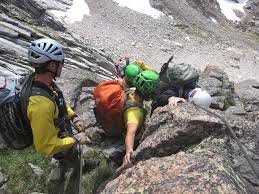 This scene was in fact enough. But I also knew I had to climb and see. As I stared at the slick rock, trying to piece together where I will put my foot in the water not to slip, I thought about John Muir’s descriptions of wild sheep. Domestic sheep he says will jump onto a slanted rock, hold on for a second, then fall backward confused. The wild sheep, though, “in the most trying situations, where the slightest want or inaccuracy would have been fatal, these always seemed to move in comfortable reliance on their strength and skill, the limits of which they never appeared to know.” Am I now up against a personal limit? Is that perhaps one of the reasons to keep pushing, to see what the limit is? Muir also suggests that wild sheep will follow a leader but will also easily break away onto one’s own trail when they wish or are compelled by circumstance. “The domestic sheep, on the contrary, is only a fraction of an animal, a whole flock being required to form an individual, just as numerous flowerets are required to make one complete sunflower.” Certainly Muir is really talking about people, in his own flowery way making a judgment that the human in tune with his or her wildness is more assured, capable, and more fully human. I’m not sure I buy his argument with its judgmental attitude that would potentially condemn those who are unable or disinclined to venture into wild places, but I can’t deny that I push myself here not just for the scenery but to see something about myself. Is Sky Pond really that much more beautiful than right here, or is it more meaningful to me because I am now alone and afraid?
This scene was in fact enough. But I also knew I had to climb and see. As I stared at the slick rock, trying to piece together where I will put my foot in the water not to slip, I thought about John Muir’s descriptions of wild sheep. Domestic sheep he says will jump onto a slanted rock, hold on for a second, then fall backward confused. The wild sheep, though, “in the most trying situations, where the slightest want or inaccuracy would have been fatal, these always seemed to move in comfortable reliance on their strength and skill, the limits of which they never appeared to know.” Am I now up against a personal limit? Is that perhaps one of the reasons to keep pushing, to see what the limit is? Muir also suggests that wild sheep will follow a leader but will also easily break away onto one’s own trail when they wish or are compelled by circumstance. “The domestic sheep, on the contrary, is only a fraction of an animal, a whole flock being required to form an individual, just as numerous flowerets are required to make one complete sunflower.” Certainly Muir is really talking about people, in his own flowery way making a judgment that the human in tune with his or her wildness is more assured, capable, and more fully human. I’m not sure I buy his argument with its judgmental attitude that would potentially condemn those who are unable or disinclined to venture into wild places, but I can’t deny that I push myself here not just for the scenery but to see something about myself. Is Sky Pond really that much more beautiful than right here, or is it more meaningful to me because I am now alone and afraid?
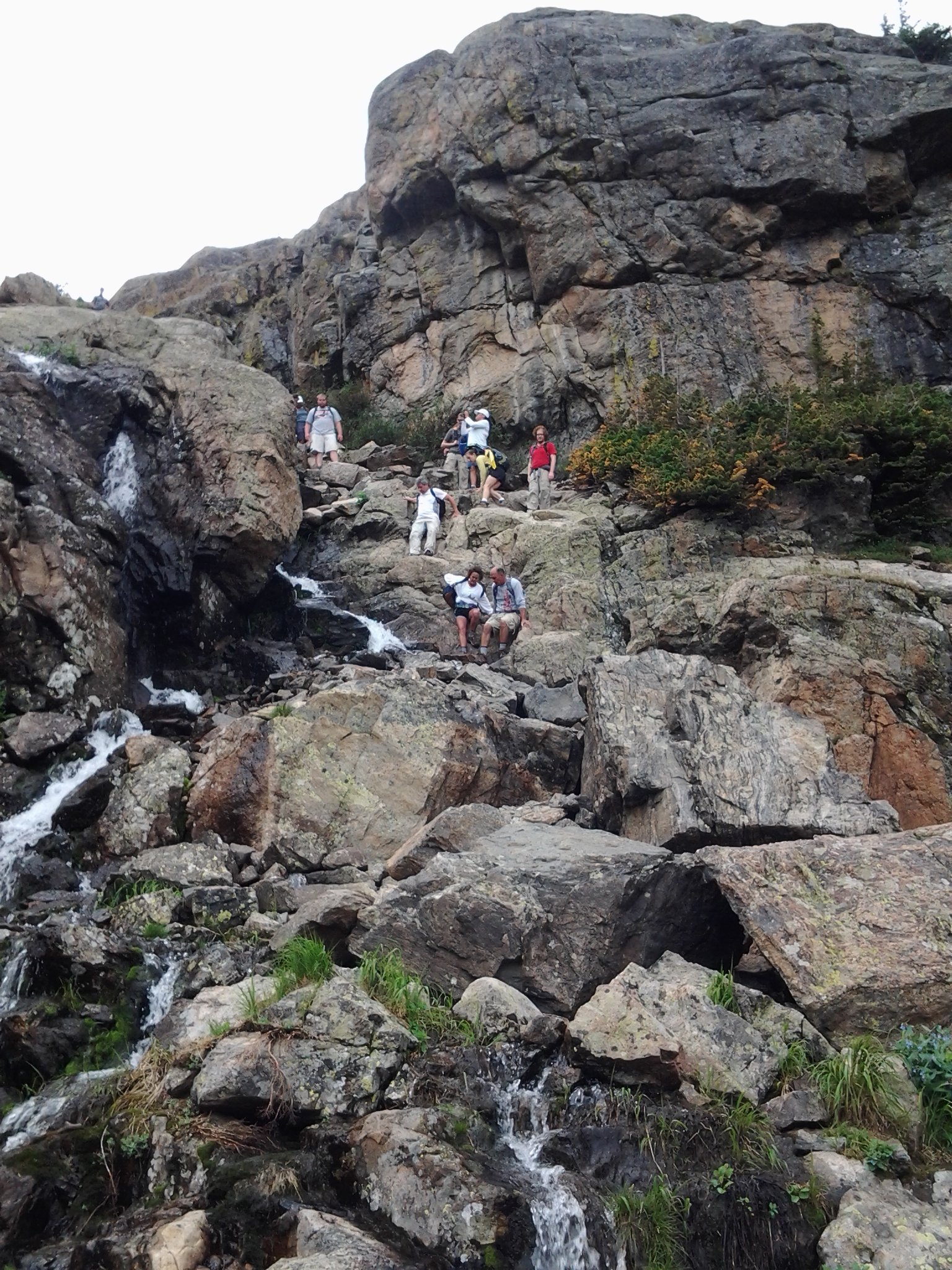 Lest I, too, sound judgmental, I should be clear that I am far from a mountaineer (this is probably already clear, though, from my reaction to this moment). I am not making value judgments about what one does or does not accomplish out in the wild. While I’m in the park, I’m not planning to climb Long’s Peak, a much more strenuous and dangerous ascent than this. Someone doing so could easily make the same judgment about me. Some can’t make it to this point, and some people go far beyond this climb, choosing a life of extremes (and Muir himself would fall into this camp, living on peaks often with nothing but his heavy overcoat and stale bread in his pockets). Who could possibly decide whether one is in tune with wildness or not based on such criteria?
Lest I, too, sound judgmental, I should be clear that I am far from a mountaineer (this is probably already clear, though, from my reaction to this moment). I am not making value judgments about what one does or does not accomplish out in the wild. While I’m in the park, I’m not planning to climb Long’s Peak, a much more strenuous and dangerous ascent than this. Someone doing so could easily make the same judgment about me. Some can’t make it to this point, and some people go far beyond this climb, choosing a life of extremes (and Muir himself would fall into this camp, living on peaks often with nothing but his heavy overcoat and stale bread in his pockets). Who could possibly decide whether one is in tune with wildness or not based on such criteria?
It seems to me, we all have our own Timberline Falls and no one can decide what that moment is for us. Those places we need to choose whether we accept and enjoy where we are or press on past our limit to see the next thing. And either choice is merely a different way of approaching the world, each with its own consequence. If we accept where we are, then we lose the next experience; if we press on, we potentially appreciate less what it is we already have.
And so it is. We is what we is.
Carefully, I picked my way up the slick rock. Above the cliff, the trail became obvious again and led me up to the next plateau. In hindsight, it’s not that difficult of a climb; it’s the uncertainty and the solitude that made me pause, but once I crested the cliff and found the trail again, I simply plowed ahead.
Lake of Glass is first, but a bracing mountain wind kept it anything but its name, a white-capped frothy turquois lake. The trail above Lake of Glass hugs a ledge then crosses a windswept saddle where water falls across a talus field. A final scramble up, and you emerge at glacial-fed Sky Pond with the spires of “The Cathedral” rising to your right and the icy slick face of Otis and Thatchtop shimmering in the sunlight to your left. It’s a breathtaking moment.
The altitude, the sun, the bracing clear wind, the shimmering jewel-like surface of the water: the world that quickly takes on another quality altogether. It’s not that this was better than a few hundred feet below; it’s that it’s of a different quality altogether—a difference in kind, not degree. There is a certain point at altitudes when you step into another dimension altogether.
Early in the hike, far below, I passed two elderly men. Clearly experienced hikers I could tell, but they moved as slowly as I could imagine. Even at my moderate pace, I saw them at a switchback above me as I rounded a switchback below—I passed them before they even made their turn. We waved our pleasantries and I left them shuffling behind, not sure how far I thought they would actually make it. As I sat on a rock and stare dazed at the peaks, the two men scrambled up to the lake barely behind me in the scope of things, reminding me that it is persistence and consistency rather than one’s gait that carries you up mountains. One, seeing me in my awe, stopped to talk and said that he has been hiking peaks in the Rockies, the Sierras, and the Cascades for over 40 years, and this is his favorite climb, the one that he returns to most often.
The pond itself is milky green, rich in glacial minerals. A cold wind whips across it. At about 11,000 feet, the air is thin, cold, and dry. Something happens as the oxygen in your blood starts to thin, a giddy euphoria that has always baffled me in terms of evolutionary advantages: why should starving brain cells feel good? Of course, I know this is a fine line. It’s easy enough to slip over into sickness: the head starts to pound, the stomach feels nauseous, and the nose starts to bleed (get me over 12,000 feet and a nosebleed is almost certain). These symptoms leave no room for misunderstanding. But the joy we can feel just this side of altitude sickness is puzzling. What kind of evolutionary benefit came from having such pleasure so close to altitude sickness and its dangers?
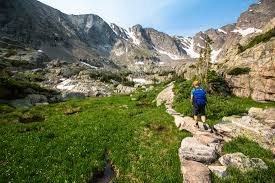 I sat awhile in the brilliant high-elevation sun and ate a few handfuls of my own concoction of gorp, bitterly cold and extremely happy. I have been happy in many different kinds of natural settings, but I tend to think of that sense of happiness as a kind of peace, of contentment or connection. At higher altitudes, I feel something different. It’s closer to what I think we mean by joy. It’s an overwhelming, full body emotion that can bring me to tears. Is it the height, is it the relief of having accomplished the journey, is it physical deprivation? Is it that you step into a realm that feels utterly of another world, a place not meant for us? Is it simply the effect of a stunningly beautiful landscape, an effect of the hike, the thrill of accomplishing a goal in different terrain, or a physiological response to the altitude? If it’s physiological, can we really call it joy? It’s the same question I faced during years of youthful psychedelic inner journeying: if it’s from a chemical, can it be true?
I sat awhile in the brilliant high-elevation sun and ate a few handfuls of my own concoction of gorp, bitterly cold and extremely happy. I have been happy in many different kinds of natural settings, but I tend to think of that sense of happiness as a kind of peace, of contentment or connection. At higher altitudes, I feel something different. It’s closer to what I think we mean by joy. It’s an overwhelming, full body emotion that can bring me to tears. Is it the height, is it the relief of having accomplished the journey, is it physical deprivation? Is it that you step into a realm that feels utterly of another world, a place not meant for us? Is it simply the effect of a stunningly beautiful landscape, an effect of the hike, the thrill of accomplishing a goal in different terrain, or a physiological response to the altitude? If it’s physiological, can we really call it joy? It’s the same question I faced during years of youthful psychedelic inner journeying: if it’s from a chemical, can it be true?
I’d been hiking in the park for a week, gotten adjusted to the altitude (far from the Iowa flatland where I was living), and yes, this felt like it, the peak moment we long for, a brief satori (brief as I’ve always imagined satori must be—do we really imagine that enlightenment is some state in which we can remain? Do we imagine we can jump into the ocean of nirvana and stay there or do we take a joyful brisk swim and climb back down the mountain, a little more able to go on with our daily lives?). But I was keenly aware of the weather. All week the storms had rolled in early (before noon instead of the more typical 2 or 3 o’clock at this time of year) and remained fierce throughout the afternoon, sometimes steady, sometimes coming in waves (rather than the more typical gully washer that quickly disappears). So incredibly deceptive these first fluffy white clouds peering over the peaks. It was about noon and the first cumulus were shining brilliant in the noon sun.
I don’t want to overplay any of this. The altitude had an effect, but I was not that high. The hike was strenuous, but not extreme. And the weather would probably still take a while to roll in. But I was certainly aware. Perhaps some degree of danger is helpful in attuning us to the setting; I noticed things about the mountains that I probably wouldn’t have had I not been watching for storms. I was at least a half hour away from treeline, on a rocky path that would certainly be slick and tricky in the rain or hail (and just two days earlier I had spent an hour hunkered down under some Engelmann Spruce by Lake Haiyaha as thunder cracked and rolled around the peaks and hail pounded the hillside into a white submission). I don’t know what the odds of lightning strikes really are at altitude; part of me said the tech climbers I could barely see high above me on Petit Grepon were the ones in danger, and they weren’t coming down, so what did I really have to worry about? But another part of me remembered that only a week before a hiker had been struck on the boulder field climbing Long’s Peak, less than a mile away. I don’t know what the odds are, but they are odds I don’t really want to take.
So I wasn’t rushing necessarily, what with the sheer wonder of high mountain air, sunshine, and diamond sparkling waters, yet I did begin to leisurely reassemble my pack—drink a little water, splash my face in the cold waters, etc.—and begin to pick my way back down to the Lake of Glass.
There between the two lakes, though, it struck me: how can I go down? Isn’t this feeling what we spend our life seeking? How could I simply descend so quickly? The feeling really is a far healthier version of those younger psychedelic forays, but the goal and the effect was the same, a clearer, more uncluttered sense of who I am, all the trappings of the day-to-day stripped away, leaving just me and the mountain.
I had my wits about me, and I knew—seeing the clouds beginning to bubble more ominously, now casting dark shadows in their broiling underbellies—that it was time to go, but I was feeling paralyzed. So beautiful, so vast. Is this the nature of joy or just oxygen depletion? The feeling made me think of nitrogen narcosis. At some point in a deep dive, divers begin to suffer the effects of nitrogen in their system, the symptom of which is a kind of drunken euphoria. If they are not helped to ascend, they can begin to do foolish things which can prove fatal at such depths. A few years earlier I had been diving in the Cayman Islands, on the edge of the Cayman trench, a canyon in the ocean floor that descends some 7,000 feet. The reef gradually slopes down to about 90 feet where the wall then drops precipitously into the depths. For a non-technical diver such as myself, 100 feet is the safe maximum depth, so this dive allows one to go just over the lip and hover at the edge of the wall, an amazing spectacle to see this field of glorious multi-colored life sinking down as far as I could see in all directions. At these depths, though, little things make a big difference. I knew on one hand that I needed to ease my way back up over the lip of the wall, but the color of that deep water was hypnotizing. All that blue. That endless wall. Don’t you just have to see?
My brother hovered 10 feet above me, waving his hands upward in a manic motion. Yes, I was in danger and was being sucked in to the scene. I shook myself out of the trance and began to ascend, but most of my body said, but look…
The two hikers passed me in my reverie on my way back down and urged me to keep moving. “It’s coming in pretty fast.” The sky over the peaks blackened. I shook myself loose and began the descent, down past the falls in the shadow of the oncoming storm, down through the meadows and into the safe haven of the tightly packed, pointed Engelmann Spruce just as lightning cracked on the ridge above. The storm was fierce with hail and lightning hitting several peaks around me. I hunkered under a stand of short spruce, watched hail bounce on boulders and shuddered at the too-close-for-comfort lightning strikes. And then it was gone, rolling off over Long’s Peak.
The descent was leisurely, peaceful. But the glow of the lake doesn’t last in the face of the afternoon crowds that were now climbing into the gorge. The trail became hot and packed and I zigged and zagged between streams of people. At Alberta Falls, the first real scenic spot on the trail (or the last on my descent) the trail was overflowing. I had seen almost no one on my ascent, but now I was in the midst of a mob.
Yes, I can be a self-righteous, better-than-you wilderness jerk: tell your kids to be quiet; go somewhere out of the way; quit talking on your cell phone for cris’sake. I know I’m full of myself. But I also was feeling good: some of these kids running around screaming will inevitably grow up to love these mountains. Some of them will want to save a piece of wildness. It is of course the never-ending conundrum: we want to save wilderness which means saving it from people. But for people to want to save it, they need to know it. We need people to get into the wild, even if the goal is then to save it from ourselves, and even if it means sharing our little piece of solitude.
My better nature takes hold, and I see promise in so many people coming to see this little slice of wildness.
And then a woman sitting on a rock wall stops me.
“Anything to see up there?”
I think it’s a joke, but she’s serious.
Once again, my better nature takes hold: “Nope, nothing worth seeing up there.”
Interview with Glenn Freeman
One of the many things I liked about this essay/memoir is the way it works on more than one level. Did you set out to make it that way, or is that something that developed in the writing of it? If the latter, can you say more about that?
Interesting question. I’d say that nothing is particularly intentional on my part besides trying to understand and convey my own thoughts. I tend to agree with Allen Ginsberg who says that any clear writing will inherently conjure other layers. I was, however, trying to bring two different narrative moments together: deciding whether or not to climb up the falls, and responding to the woman near the trailhead. I think these two separate moments push against each other and possibly open up the essay to the different levels you’re seeing in the piece.
I’m still curious about the last line of this essay, which begins, “Once again my better nature takes hold” and ends with your saying to the lone climber, “Nope, nothing worth seeing up there.” By “better nature,” did you mean you wished to guide the climber away from something that would be too difficult or not interesting enough for her? Or were you in a way protecting the mountain from one who would not appreciate it? Or was there something else going on there? Can you talk a little bit about that?
I’d hoped that the last line is emotionally complex. On one hand, it’s purely ironic: it’s not my better nature. It’s a purely selfish sentiment: I want to keep the mountain for my own experience of solitude and wilderness. But the other possibilities you point to are also true: despite realizing that people need to experience a landscape before they love and protect it, the environment can’t survive if too many people go there, so it’s a kind of better nature to warn at least some away (and I suppose that those who can’t even imagine the value of climbing are probably the easiest to warn away). Then again, I might also argue that those without that imagination most profoundly need the experience. So who knows what I really mean.
I was interested in the way deep-sea diving – possibly the opposite of mountain climbing! – comes up as a thread in the denouement of this story. Can you talk a little more about the similarities, differences you see in these two pursuits? Do you have a strong preference for one over the other?
Because of the training, gear, and cost, diving can be the more difficult adventure—you need to be certified, buy or rent gear, and most often you need a boat to even get to the best diving sites. Anyone can hike or climb on the level I’m thinking about (which is not real technical climbing, which does require some training and gear, but is far beyond the experience I’m talking about). The act of actually diving, though, is far easier. If you want, you can simply descend, drift around, and ascend again and have an absolutely amazing experience. Hiking is necessarily a workout. But both offer very parallel experiences: they both take you to world beyond the pale of our normal worlds, a place that is ultimately not meant for us, yet we feel compelled to experience.
From the perspective of this reader, ensconced in the Blue Mountains of Virginia (and previously slightly acquainted with the Adirondack Shield), the Rocky Mountains seem exotic and rather mysterious. Have you climbed other ranges? Can you talk a little about the differences you’ve seen?
I’m so glad you brought up the Blue Ridge. I grew up in Maryland and still consider those mid-Atlantic Appalachian mountains part of who I am. I grew up hiking the Smokies, the Blue Ridge, the Shenandoahs. I’ve also hiked the northern ranges—the Adirondacks, the Greens, the Whites. I’ve hiked much of the Appalachian Trail (in different sections at different times—I have not attempted a through-hike of the trail). I’ve also hiked in a good deal of the western ranges, for instance, the Olympics, the Cascades, the Klamath range. They have all offered me profound experiences. The western mountains feel different to me, though, in that the environment at altitude feels like a beautiful but alien world—I don’t feel designed for survival there (though I know many people do in fact thrive in such rugged environments); those mixed hardwood forests of the eastern mountains feel profoundly like home.
Is this essay part of a larger collection? If so, can you tell us about it? If not, can you imagine such a thing?
The essay is part of a larger project I’m working on called The Sound of My True Country (a phrase borrowed from a Sam Hamill poem). It’s a mixed-genre collection focused on relationships with varied environments (and related to your last question, a central essay of the book is about hiking in the Catoctins near where I lived in Maryland as a kid). At the heart of the book is an essay about meeting the Batwa pygmies of the volcano region of Uganda. They are conservation refugees, removed from their ancestral homelands in the name of preservation. It made me think a great deal about the idea of land as home and the wisdom of a place. The Batwa know those forests better than any people, and yet they have no way to use or share that wisdom. And they have no way to survive outside of that environment and now are suffering as squatters on a land they have no connection to. This issue is the primary thread running through the book: what is “home” and how do we know and relate to that place?
Follow us!Share this post with your friends.

